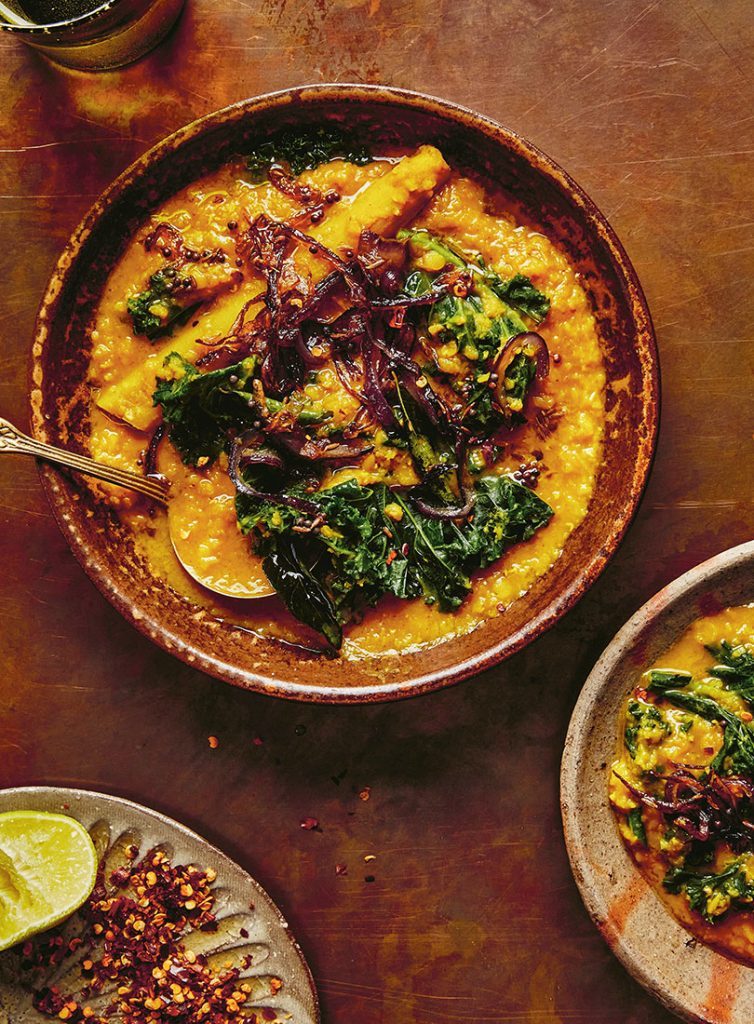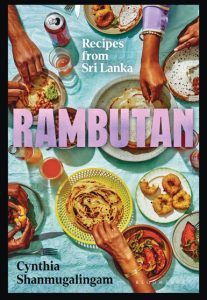Coconut Dal With Kale
Cynthia Shanmugalingam

Serves
4Ingredients
| FOR THE DAL | |
| 300g red split lentils or toor lentils | |
| 3 garlic cloves, peeled and halved lengthways | |
| 1 lemongrass stalk, bruised | |
| 1½ teaspoons salt | |
| ½ teaspoon Sri Lankan curry powder (see recipe) | |
| 4cm-piece of pandan leaf (optional) | |
| 1½ teaspoons ground turmeric | |
| 100ml coconut milk | |
| 3–4 small handfuls of kale (about 200g) | |
| 1 teaspoon chilli flakes (optional) | |
| FOR THE TEMPER | |
| 1 tablespoon coconut or vegetable oil | |
| 1 small red onion, peeled and finely sliced | |
| ½ teaspoon mustard seeds | |
| ½ teaspoon cumin seeds | |
| 10 fresh curry leaves | |
| ½ lime | |
| SRI LANKAN CURRY POWDER | |
| 30g coriander seeds | |
| 15g cumin seeds | |
| 15g fennel seeds | |
| 15g black peppercorns | |
| 2 tablespoons coconut or vegetable oil | |
| 8–10 fresh curry leaves | |
| 70g dried Kashmiri or medium-hot red chillies | |
| ¼ teaspoon ground turmeric |
In war or other times of national crisis, dal is rationed out by the Sri Lankan government as one of life’s essentials. Cooked with lemongrass and, if you can get it, pandan leaf (which adds a warm, vanilla flavour) as well as coconut milk, turmeric, curry leaves, garlic and lime, this dal is distinctively light and restorative, and is worlds away from its Indian counterparts like black dal makhani made with cream, or tarka dal made with butter. There is no other dal quite like it, and I encourage you to try adding roasted squash, roasted pumpkin or roasted sweet potato. This one is one of the ways my mum would cook it when she was too short on time to make a separate kale curry. She’d simply stir the leaves in very close to the end of cooking so they retained their bright green flavour and nutrients.
SRI LANKAN CURRY POWDER
It’s worth making your own Sri Lankan curry powder. It takes ten minutes and will keep in the fridge in a jar for three months, but scale the quantities up or down as you need to.
View the recipe collection here
Instructions
| 1. | Pour the lentils into a saucepan and rinse loosely under the tap then drain well. |
| 2. | Cover the lentils with water until they’re submerged by about 5cm. |
| 3. | Add all the other dal ingredients except the turmeric, coconut milk, kale and chilli flakes and bring to a boil over a medium-high heat. |
| 4. | Skim off any scum and turn the heat down, so the lentils are simmering. |
| 5. | Add the turmeric and simmer for 12–15 minutes until the lentils are tender. There’s no need to stir here, you can basically forget about them except to check they’re not bubbling too vigorously. |
| 6. | Drain off about 80 percent of the liquid. You don’t want it to be too wet and soupy because you’re adding coconut milk later. |
| 7. | Stir in coconut milk and kale and allow to simmer gently for 2–3 minutes until the kale is bright green. |
| 8. | Take out a little kale to try; it shouldn’t taste raw but should be soft with a firm bite. |
| 9. | Remove from the heat and transfer to your serving bowl. |
| 10. | In a small frying pan, make the temper. Heat the oil on a medium-high heat (careful, it will splutter a little). |
| 11. | When hot, add the onion and cook, stirring occasionally, for 3–5 minutes until it starts to turn golden brown. |
| 12. | Add the mustard seeds, cumin seeds and curry leaves and cook for a couple of minutes until the curry leaves are bright green. Be careful not to burn the spices! |
| 13. | Pour the whole temper, oil included, onto the cooked dal. |
| 14. | Squeeze lime over it and sprinkle over the chilli flakes, if using, just before serving. |
| 15. | SRI LANKAN CURRY POWDER |
| 16. | Make sure the windows are open and the ventilation is on, because roasting the chillies will kick up an intense smell which carries through the house. |
| 17. | In a dry pan over a low-medium heat, roast the coriander, cumin, fennel and black peppercorns for 1–2 minutes, stirring regularly, until they begin to be really fragrant, then pour them into a bowl. |
| 18. | Add the oil to the pan and cook the curry leaves and dried chillies for 2–3 minutes, stirring often. |
| 19. | Remove from the heat and when cool, blitz in a spice grinder or mini food processor until fine – you can blitz it in batches if you need to. |
| 20. | Stir in the turmeric and put the whole lot in a jam jar. |
 This is an edited extract
This is an edited extract
from Rambutan: Recipes
from Sri Lanka by Cynthia
Shanmugalingam, photography
by Alex Lau, published by
Bloomsbury $52.99. See
our review.
